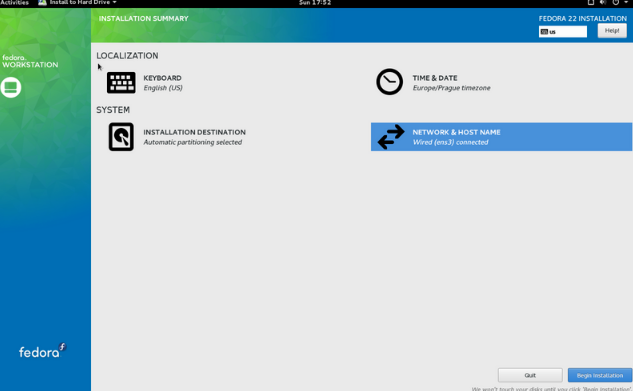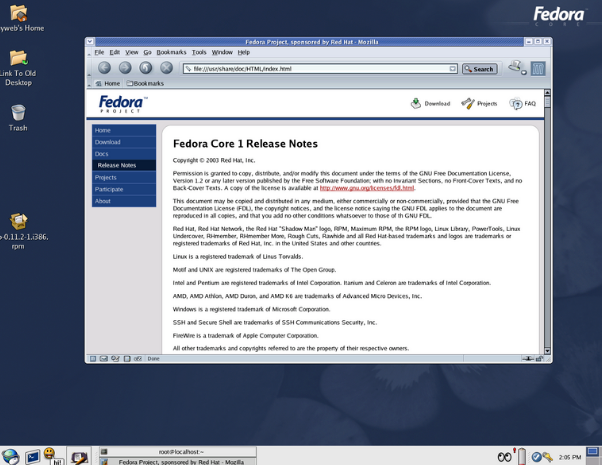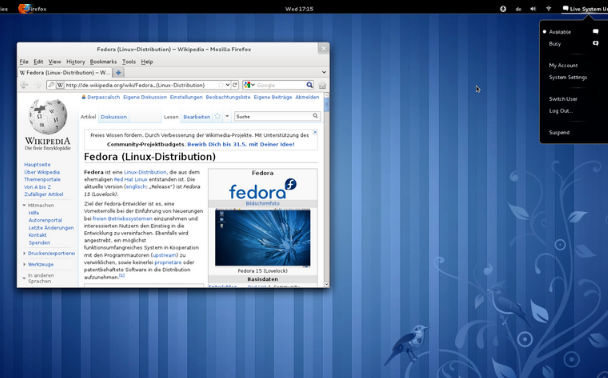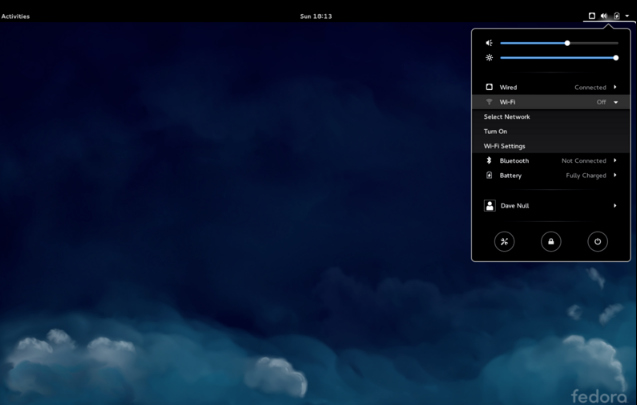Fedora is a Linux distribution developed by the community-supported Fedora Project which is sponsored primarily by Red Hat, a subsidiary of IBM, with additional support from other companies. Fedora contains software distributed under various free and open-source licenses and aims to be on the leading edge of free technologies. Fedora is the upstream source of the commercial Red Hat Enterprise Linux distribution and for CentOS. Fedora is a fork of Red Hat Linux since RHL was discontinued in 2003. Since the release of Fedora 30, five different editions are currently available: Workstation, focused on the personal computer, Server for servers, CoreOS, focused on cloud computing, Silverblue, focused on an immutable desktop specialized to container-based workflows and IoT, focused on IoT devices. (As of February 2016), Fedora has an estimated 1.2 million users, including Linus Torvalds ((As of May 2020)), creator of the Linux kernel.
- fedora
- silverblue
- kernel
1. Features
Fedora has a reputation for focusing on innovation, integrating new technologies early on and working closely with upstream Linux communities.[1][2] Making changes upstream instead of specifically for Fedora ensures that the changes are available to all Linux distributions.
Fedora has a relatively short life cycle: each version is usually supported for at least 13 months, where version X is supported only until 1 month after version X+2 is released and with approximately 6 months between most versions.[3] Fedora users can upgrade from version to version without reinstalling.[4][5]
The default desktop environment in Fedora is GNOME and the default user interface is the GNOME Shell. Other desktop environments, including KDE Plasma, Xfce, LXQt, LXDE, MATE, Cinnamon, and i3 are available and can be installed.[6][7]
1.1. Package Management
Most Fedora editions use the RPM package management system, using DNF as a tool to manage the RPM packages.[8] DNF uses libsolv, an external dependency resolver.[8] Flatpak is also included by default, and support for Ubuntu's snaps can be added. Fedora uses Delta RPM when updating installed packages to provide delta updates. A Delta RPM contains the difference between an old and new version of a package. This means that only the changes between the installed package and the new one are downloaded, reducing network traffic and bandwidth consumption.
The Fedora CoreOS and Silverblue editions use rpm-ostree,[9] a hybrid transactional image/package system to manage the host. Traditional DNF (or other systems) should be used in containers.
1.2. Security
Fedora uses Security-Enhanced Linux by default, which implements a variety of security policies, including mandatory access controls, which Fedora adopted early on.[10] Fedora provides a hardening wrapper, and does hardening for all of its packages by using compiler features such as position-independent executable (PIE).[11]
1.3. Software
Fedora comes preinstalled with a wide range of software such as LibreOffice and Firefox. Additional software is available from the software repositories and can be installed using the DNF package manager or GNOME Software.
Additionally, extra repositories can be added to the system, so that software not available in Fedora can be installed easily.[12] Software that is not available via official Fedora repositories, either because it doesn't meet Fedora's definition of free software or because its distribution may violate US law, can be installed using third-party repositories. Popular third-party repositories include RPM Fusion free and non-free repositories. Fedora also provides users with an easy-to-use build system for creating their own repositories called Copr.[13]
Since the release of Fedora 25, the operating system defaults to the Wayland display server protocol, which replaced the X Window System.[14]
1.4. System Installer


Fedora uses Anaconda as the system installer.
1.5. Editions
Beginning with Fedora version 30, it is available in five editions:[15]
- Fedora Workstation – It targets users who want a reliable, user-friendly, and powerful operating system for their laptop or desktop computer. It comes with GNOME by default but other desktops can be installed or can be directly installed as Spins.
- Fedora Server – Its target usage is for servers. It includes the latest data center technologies. This edition doesn't come with a desktop environment, but one can be installed. From Fedora 28, Server Edition will deliver Fedora Modularity,[16] adding support for alternative update streams for popular software such as Node.js and Go.
- Fedora CoreOS – It provides a minimal image of Fedora which includes just the bare essentials. It is meant for deployment in cloud computing. It provides Fedora CoreOS images which are optimized minimal images for deploying containers[17].
- Fedora IoT – Images of Fedora tailored to running on Internet of Things devices.
- Fedora Silverblue – It targets users who want an immutable desktop and developers who use container based workflows.
A Live USB drive can be created using Fedora Media Writer or the dd command.[18] It allows users to try Fedora without making changes to the hard disk.
1.6. Labs
Similar to Debian blends, the Fedora Project also distributes custom variations of Fedora called Fedora Labs.[19] These are built with specific sets of software packages, targeting specific interests such as gaming, security, design,[20] robotics,[21][22] and scientific computing[23] (that includes SciPy, Octave, Kile, Xfig and Inkscape).
The Fedora AOS (Appliance Operating System) was a specialized spin of Fedora with reduced memory footprint for use in software appliances. Appliances are pre-installed, pre-configured, system images. This spin was intended to make it easier for anyone (developers, independent software vendors (ISV), original equipment manufacturers (OEM), etc.) to create and deploy virtual appliances.
1.7. Spins and Remixes
The Fedora project officially distributes different variations called "Fedora Spins"[24] which are Fedora with different desktop environments (GNOME is the default desktop environment). The current official spins, as of Fedora 34, are KDE, Xfce, LXQt, MATE-Compiz, Cinnamon, LXDE, SOAS, and i3.
In addition to Spins, which are official variants of the Fedora system, the project allows unofficial variants to use the term "Fedora Remix" without asking for further permission, although a different logo (provided) is required.[25]
1.8. Architectures
x86-64 and ARM-hfp are the primary architectures supported by Fedora.[26] Pidora[27] and FedBerry[28] are specialized Fedora distributions for the Raspberry Pi, which support the Raspberry Pi as well as other ARM and SBC devices.[29] As of release 26, Fedora also supports ARM AArch64, IBM Power64, IBM Power64le, IBM Z ("s390x"), MIPS-64el, MIPS-el, RISC-V as secondary architectures.
Fedora 28 was the last release that supported ppc64 and users are advised to move to the little endian ppc64le variant.[30]
1.9. Alternatives
The Fedora Project also distributes several other versions[31] with less use cases than mentioned above, like network installers and minimal installation images. They are intended for special cases or expert users that want to have custom installations or configuring Fedora from scratch.
In addition, all acceptable licenses for Fedora (including copyright, trademark, and patent licenses) must be applicable not only to Red Hat or Fedora, but also to all recipients downstream. This means that any "Fedora-only" licenses, or licenses with specific terms that Red Hat or Fedora meets but that other recipients would not are not acceptable (and almost certainly non-free, as a result).
2. History
The name of Fedora derives from Fedora Linux, a volunteer project that provided extra software for the Red Hat Linux distribution, and from the characteristic fedora hat used in Red Hat's "Shadowman" logo. Warren Togami began Fedora Linux in 2002 as an undergraduate project at the University of Hawaii,[32] intended to provide a single repository for well-tested third-party software packages so that non-Red Hat software would be easier to find, develop, and use. The key difference between Fedora Linux and Red Hat Linux was that Fedora's repository development would be collaborative with the global volunteer community.[33] Fedora Linux was eventually absorbed into the Fedora Project, carrying with it this collaborative approach.[34]
Fedora Linux was launched in 2003, when Red Hat Linux was discontinued.[35] Red Hat Enterprise Linux was to be Red Hat's only officially supported Linux distribution, while Fedora was to be a community distribution.[35] Red Hat Enterprise Linux branches its releases from versions of Fedora.[36]
Before Fedora 7, Fedora was called Fedora Core after the name of one of the two main software repositories - Core and Extras. Fedora Core contained all the base packages that were required by the operating system, as well as other packages that were distributed along with the installation CD/DVDs, and was maintained only by Red Hat developers. Fedora Extras, the secondary repository that had been included since Fedora Core 3, was community-maintained and not distributed along with the installation CD/DVDs. Upon the release of Fedora 7, the distinction between Fedora Core and Fedora Extras was eliminated.[37]
Since the release of Fedora 21, as an effort to modularize the Fedora distribution and make development more agile,[38][39] three different versions are available: Workstation, focused on the personal computer, Server and Atomic for servers, Atomic being the version meant for cloud computing.[15]
Fedora is a trademark of Red Hat, Inc. Red Hat's application for trademark status for the name "Fedora" was disputed by Cornell University and the University of Virginia Library, creators of the unrelated Fedora Commons digital repository management software.[40] The issue was resolved and the parties settled on a co-existence agreement that stated that the Cornell-UVA project could use the name when clearly associated with open source software for digital object repository systems and that Red Hat could use the name when it was clearly associated with open source computer operating systems.[41]
In April 2020, project leader Matthew Miller announced that Fedora Workstation would be shipping on select new ThinkPad laptops, thanks to a new partnership with Lenovo.[42]
3. Development and Community

Development of the operating system and supporting programs is headed by the Fedora Project, which is composed of a community of developers and volunteers, and also Red Hat employees.[43] The Council is the top-level community leadership and governance body. Other bodies include the Fedora Engineering Steering Committee, responsible for the technical decisions behind the development of Fedora, and Fedora Mindshare Committee which coordinates outreach and non-technical activities, including representation of Fedora Worldwide e.g.: Ambassadors Program, CommOps team and Marketing, Design and Websites Team.[44]
4. Releases




Fedora has a relatively short life cycle: version X is supported only until 1 month after version X+2 is released and with approximately 6 months between most versions, meaning a version of Fedora is usually supported for at least 13 months, possibly longer.[3] Fedora users can upgrade from version to version without reinstalling.[4][5]
The current release is Fedora 34, which was released on 27 April 2021.[45] Template:Releases Fedora Linux Template:Timeline Fedora Linux
4.1. Rawhide
Rawhide is the development tree for Fedora.[46] This is a copy of a complete Fedora distribution where new software is added and tested, before inclusion in a later stable release. As such, Rawhide is often more feature rich than the current stable release. In many cases, the software is made of CVS, Subversion or Git source code snapshots which are often actively developed by programmers. Although Rawhide is targeted at advanced users, testers, and package maintainers, it is capable of being a primary operating system. Users interested in the Rawhide branch often update on a daily basis and help troubleshoot problems.[46] Rawhide users do not have to upgrade between different versions as it follows a rolling release update model.
5. Extra Packages for Enterprise Linux (EPEL)
EPEL is a repository of extra packages published by the Fedora project, which can be expected to work in RHEL and RHEL-compatible systems. EPEL is organised by a Fedora Special Interest Group. EPEL packages are usually based on their Fedora counterparts and will never conflict with or replace packages in the base Enterprise Linux distributions. EPEL uses much of the same infrastructure as Fedora, including buildsystem, bugzilla instance, updates manager, mirror manager and more.[47]
References
- Yegulalp, Serdar (22 November 2016). "Fedora 25 stakes out leading edge, not bleeding edge". http://www.infoworld.com/article/3143141/linux/fedora-25-stakes-out-leading-edge-not-bleeding-edge.html.
- "Staying close to upstream projects". Fedora Project. //fedoraproject.org/wiki/Staying_close_to_upstream_projects.
- "Fedora Release Life Cycle". Fedora Project. https://fedoraproject.org/wiki/Fedora_Release_Life_Cycle.
- "FedUp". Fedora Project. //fedoraproject.org/wiki/FedUp.
- "Fedora 23 Release Notes: 3.2.4. System Upgrades with DNF". Fedora Project. https://docs.fedoraproject.org/en-US/Fedora/23/html/Release_Notes/sect-Release_Notes-Changes_for_Sysadmin.html.
- Brodkin, Jon (15 January 2013). "How to install the MATE and Cinnamon desktops on Fedora 18". Ars Technica. https://arstechnica.com/information-technology/2013/01/installing-the-mate-and-cinnamon-desktops-on-fedora-18/.
- Mutai, Josphat (2 May 2019). "Install Deepin Desktop Environment on Fedora 30". https://computingforgeeks.com/how-to-install-deepin-desktop-environment-on-fedora/.
- Edge, Jake (2014-01-15). "DNF and Yum in Fedora". LWN.net. https://lwn.net/Articles/580223/.
- "⚛? Hybrid image/package system with atomic upgrades and package layering: coreos/rpm-ostree". 5 December 2019. https://github.com/coreos/rpm-ostree.
- Spenneberg, Ralf (August 2006). "Security Hardened - Mandatory Access Control with SELinux". Linux New Media USA. http://w3.linux-magazine.com/issue/69/Access_Control_with_SELinux.pdf.
- "Harden All Packages". Fedora Project. http://fedoraproject.org/wiki/Changes/Harden_All_Packages.
- "Adding, Enabling, and Disabling a DNF Repository". Fedora Project. https://docs.fedoraproject.org/en-US/Fedora/26/html/System_Administrators_Guide/sec-Managing_DNF_Repositories.html.
- "Fedora Copr". Fedora Project. https://copr.fedorainfracloud.org/.
- Staff, Ars (2016-12-16). "Fedora 25: With Wayland, Linux has never been easier (or more handsome)". Ars Technica. https://arstechnica.com/gadgets/2016/12/fedora-25-review-the-best-linux-distro-of-2016-arrived-at-the-last-moment/.
- "Fedora". https://getfedora.org/.
- "Fedora Modularity". https://docs.pagure.org/modularity/.
- https://getfedora.org/en/coreos?stream=stable
- "Preparing Boot Media". Red Hat. https://docs.fedoraproject.org/en-US/Fedora/26/html/Installation_Guide/sect-preparing-boot-media.html.
- "Fedora Labs". Fedora Project. https://labs.fedoraproject.org.
- "Fedora Design Suite". https://labs.fedoraproject.org/en_GB/design-suite.
- "Fedora Robotics Edition". Fedora Project. https://spins.fedoraproject.org/robotics/.
- "Fedora Robotics Wiki". Fedora Project. //fedoraproject.org/wiki/Robotics.
- "Fedora Scientific". Fedora Project. https://labs.fedoraproject.org/en_GB/scientific/.
- "Fedora Spins". https://spins.fedoraproject.org/index.html.en.
- "Remix - Fedora Project Wiki". https://fedoraproject.org/wiki/Remix.
- "Architectures". Fedora Project. //fedoraproject.org/wiki/Architectures.
- "Pidora - Raspberry Pi Fedora Remix". http://www.pidora.ca.
- "FedBerry - Fedora Remix for Raspberry Pi 2/3". fedberry.org. http://fedberry.org.
- "Fedora ARM Supported Devices". https://fedoraproject.org/wiki/Architectures/ARM#Supported_Hardware_and_Devices.
- "DiscontinuePPC64 - Fedora Project Wiki". https://fedoraproject.org/wiki/Changes/DiscontinuePPC64.
- "Fedora Alternative Downloads". https://alt.fedoraproject.org/.
- "Warren Togami". fedoraproject.org. //fedoraproject.org/wiki/User:Wtogami?rd=WarrenTogami.
- Barr, Joe (1 October 2003). "Warren Togami on the new Fedora Project". Linux.com. http://www.linux.com/archive/feature/31767.
- Togami, Warren (February 2006). "Why Fedora?" (ODP). http://togami.com/~warren/archive/2006/lax_seminar_fedora_feb_2006.odp.
- Johnson, Michael K. (22 September 2003). "Fedora Project: Announcing New Direction". Fedora development (Mailing list). Retrieved 18 October 2007. http://www.redhat.com/archives/rhl-list/2003-September/msg00064.html
- Burke, Tim (August 2006). "The Fedora Project and Red Hat Enterprise Linux, part 4". Red Hat. http://www.redhat.com/magazine/022aug06/features/fedora_rhel_4/.
- "Releases/7". Fedora Project. //fedoraproject.org/wiki/Releases/7.
- Miller, Matthew (19 March 2014). "Fedora Present and Future: a Fedora.next 2014 Update (Part I, "Why?")". Fedora Magazine. https://fedoramagazine.org/fedora-present-and-future-a-fedora-next-2014-update-part-i-why/.
- Corbet, Jonathan (16 March 2016). "Modularizing Fedora". LWN.net. https://old.lwn.net/Articles/680278/.
- Becker, David (21 November 2003). "Red Hat, researchers in name tiff". CBS Interactive Inc.. http://news.cnet.com/2100-7344_3-5110750.html.
- "Fedora Repository Project History". http://www.fedora-commons.org/about/history.
- Miller, Matthew (2020-04-24). "Coming soon: Fedora on Lenovo laptops!". https://fedoramagazine.org/coming-soon-fedora-on-lenovo-laptops/.
- "Overview - Fedora Project". https://docs.fedoraproject.org/en-US/project/.
- "Leadership - Fedora Project". https://docs.fedoraproject.org/en-US/project/leadership/index.html.
- "Fedora 34 is officially here!". 27 April 2021. https://fedoramagazine.org/announcing-fedora-34/.
- "Releases/Rawhide". Fedora Project. https://fedoraproject.org/wiki/Releases/Rawhide?rd=Rawhide#Using_Rawhide.
- https://fedoraproject.org/wiki/EPEL
